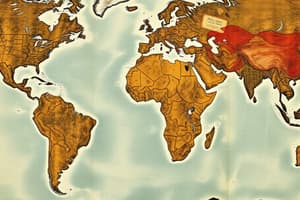Podcast
Questions and Answers
Which era saw the formation of the supercontinent Pangaea?
Which era saw the formation of the supercontinent Pangaea?
- Cenozoic era
- Jurassic era
- Mesozoic era
- Paleozoic era (correct)
What ocean surrounded the supercontinent Pangaea?
What ocean surrounded the supercontinent Pangaea?
- Panthalassa ocean (correct)
- Indian Ocean
- Atlantic Ocean
- Arctic Ocean
Who proposed the theory of continental drift?
Who proposed the theory of continental drift?
- Isaac Newton
- Galileo Galilei
- Alfred Wegener (correct)
- Charles Darwin
What geological process led to the breaking up of Pangaea?
What geological process led to the breaking up of Pangaea?
Which mountain range was formed when Europe and Asia collided during the formation of Pangaea?
Which mountain range was formed when Europe and Asia collided during the formation of Pangaea?
What was the accepted premise explaining the wide distribution of similar fossils on different continents before Wegener published his work?
What was the accepted premise explaining the wide distribution of similar fossils on different continents before Wegener published his work?
Which evidence supports the existence of Pangaea based on the text?
Which evidence supports the existence of Pangaea based on the text?
What does the distribution of fossil species on different continents suggest?
What does the distribution of fossil species on different continents suggest?
What do rock strata patterns that match on different continents indicate?
What do rock strata patterns that match on different continents indicate?
Based on the text, what is a significant implication of finding tropical plants' fossils in Antarctica?
Based on the text, what is a significant implication of finding tropical plants' fossils in Antarctica?
What is the literal definition of Pangaea?
What is the literal definition of Pangaea?
Approximately how long ago did Gondwana begin to break apart?
Approximately how long ago did Gondwana begin to break apart?
What did Alfred Wegener notice that led to the proposal of a supercontinent millions of years ago?
What did Alfred Wegener notice that led to the proposal of a supercontinent millions of years ago?
What was the sea that formed between Laurasia and Gondwana?
What was the sea that formed between Laurasia and Gondwana?
What geological process led to the breaking up of Pangaea approximately 200 million years ago?
What geological process led to the breaking up of Pangaea approximately 200 million years ago?
Flashcards are hidden until you start studying
Study Notes
Pangaea Formation
- The supercontinent Pangaea formed during the Paleozoic era, specifically in the Permian period, roughly 335 to 250 million years ago.
- The single ocean that surrounded Pangaea was called Panthalassa.
Continental Drift & Pangaea's Breakup
- Alfred Wegener proposed the theory of continental drift in 1912.
- The breaking up of Pangaea was caused by the forces of plate tectonics, specifically the movement of Earth's tectonic plates.
- The collision of Europe and Asia during Pangaea's formation created the Ural Mountains.
Evidence of Pangaea
- Before Wegener's theory, the prevailing explanation for similar fossils on different continents was that land bridges had once connected them.
- Evidence supporting the existence of Pangaea includes:
- Matching rock strata patterns on different continents.
- The distribution of fossil species across various continents.
- The discovery of tropical plant fossils in Antarctica, implying a different climate for the continent in the past.
- The distribution of fossil species across different continents suggests that the continents were once joined together.
- Matching rock strata patterns on different continents indicate a shared geological history.
- The discovery of tropical plant fossils in Antarctica suggests that the continent was once located in a warmer region.
Pangaea's Significance & Details
- The word Pangaea literally means “all Earth.”
- Gondwana, one of the two main parts of Pangaea, began to break apart approximately 180 million years ago.
- Wegener's observations of the apparent fit of the continents and the distribution of similar fossils across different continents led him to propose the existence of a supercontinent millions of years ago.
- The Tethys Sea formed between Laurasia and Gondwana, the two main parts of Pangaea.
- Pangaea broke apart approximately 200 million years ago due to the movement of tectonic plates.
Studying That Suits You
Use AI to generate personalized quizzes and flashcards to suit your learning preferences.




